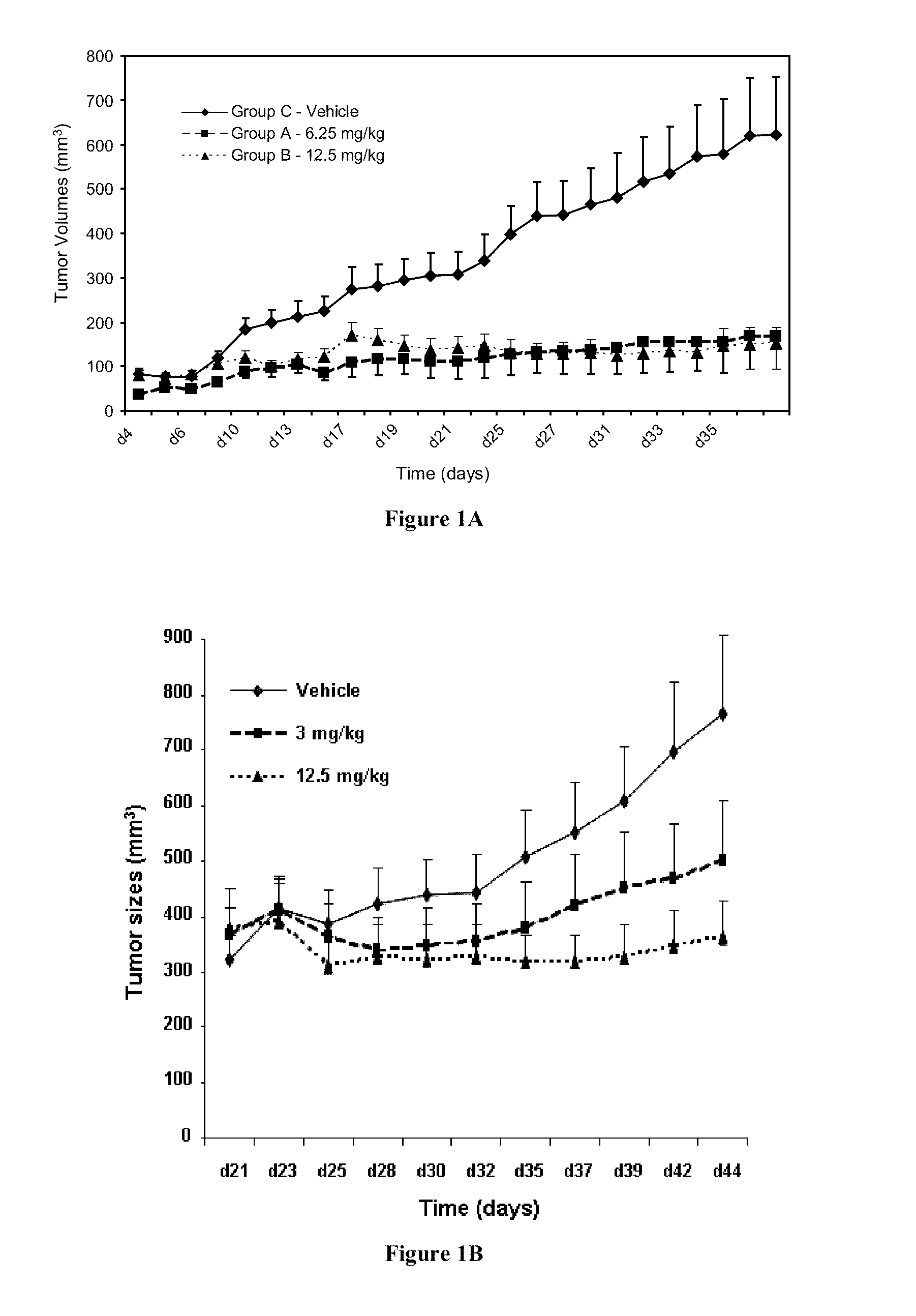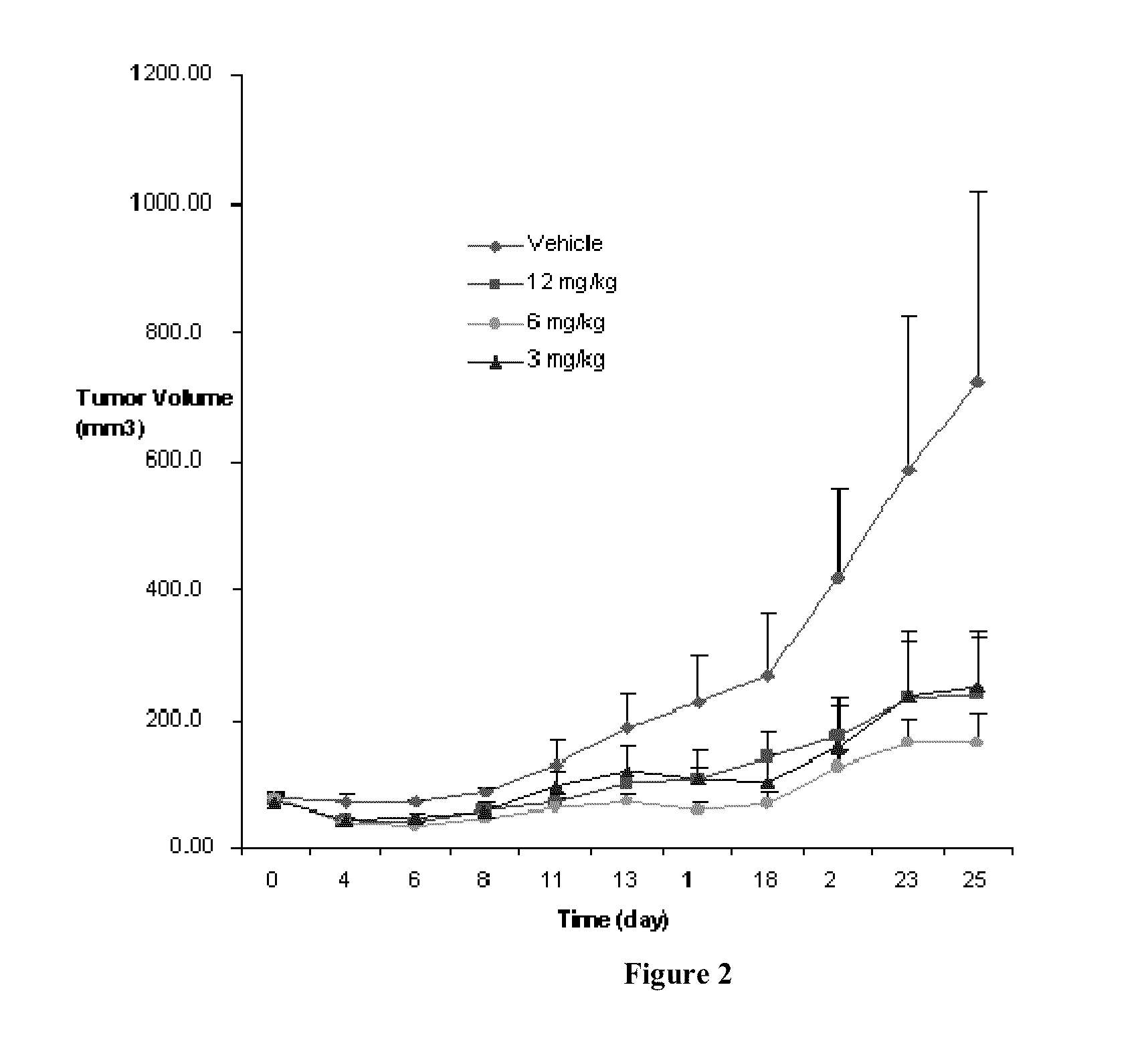Quinazolinone Compounds and Methods of Use Thereof
a technology of quinazolinone and compounds, applied in the field of quinazolinone compounds, can solve the problems of mitotic arrest and induction of programmed cell death, cell cycle arrest and cell death, and cell death
- Summary
- Abstract
- Description
- Claims
- Application Information
AI Technical Summary
Problems solved by technology
Method used
Image
Examples
example 1
General procedure A: Synthesis of N-(3-amino-propyl)-3-chloro-N—[(R)-1-(7-chloro-4-oxo-3-phenylamino-3,4-dihydro-quinazolin-2-yl)-but-3-ynyl]-2-fluoro-benzamide (1)
General procedure A, Step 1: [(R)-1-(7-Chloro-4-oxo-3-phenylamino-3,4-dihydro-quinazolin-2-yl)-but-3-ynyl]-carbamic acid tert-butyl ester
[0138]
[0139]To a mixture of (R)-2-tert-butoxycarbonylamino-pent-4-ynoic acid (5.0 g, 23.5 mmol) in anhydrous pyridine (20 ml) were added 2-amino-4-chloro-benzoic acid (4.03 g, 23.5 mmol) and triphenyl phosphite (7.40 ml). The reaction mixture was then heated at 55° C. for 16 h. To this was added phenylhydrazine (2.8 ml, 28.2 mmol,). The resulting mixture was stirred at 100° C. for 8 h. After the solvent was removed, the residue was purified by flash column (hexane to 20% ethyl acetate in hexane) to give [(R)-1-(7-chloro-4-oxo-3-phenylamino-3,4-dihydro-quinazolin-2-yl)-but-3-ynyl]-carbamic acid tert-butyl ester (5.5 g, 53.4%) as off-white solid. M.p. 155-157° C. [LC-MS]: 439 [M+H]. 400 MH...
example 2
General procedure A, Step 2: 2-((R)-1-Amino-but-3-ynyl)-7-chloro-3-phenylamino-3H-quinazolin-4-one
[0140]
[0141]To a mixture of (R)-[1-(7-chloro-4-oxo-3-phenylamino-3,4-dihydro-quinazolin-2-yl)-but-3-ynyl]-carbamic acid tert-butyl ester (5.35 g, 12.2 mmol) in methanol (65 ml) was added HCl in dioxane (4M, 20 ml). The resulting solution was stirred and the reaction completion was monitored using HPLC / LCMS. The solvent was then removed and the mixture was triturated with diethyl ether to afford 2-((R)-1-amino-but-3-ynyl)-7-chloro-3-phenylamino-3H-quinazolin-4-one (4.60 g, 100%) as off-white solid. M.p. 175-180° C. LCMS: m / e 339 [M+H]. 1H NMR: (DMSO d6) δ 9.27 (s, 1H), 8.73 (s, br, 3H), 8.15 (d, J=8.4 Hz, 1H), 7.79 (d, J=2.0 Hz, 1H), 7.70 (dd, J=2.0 and 8.4 Hz, 1H), 7.32 (t, J=8.0 Hz, 2H), 6.92 (t, J=7.6 Hz 1H), 6.68 (m, 2H), 4.90, 4.58 (m, 1H, rotomers), 3.18 (m, 1H), 3.08 (m 2H).
example 3
General procedure A, Step 3: 2-{3-[(R)-1-(7-chloro-4-oxo-3-phenylamino-3,4-dihydro-quinazolin-2-yl)-but-3-ynylamino]-propyl}-isoindole-1,3-dione
[0142]
[0143]To a mixture of (R)-(1-amino-but-3-ynyl)-7-chloro-3-phenylamino-3H-quinazolin-4-one (4.60 g, 12.2 mmol) and diisopropylethylamine (DIPEA) (5.5 ml) in dichloromethane (60 ml) was added a solution of 3-(1,3-dioxo-1,3-dihydro-isoindol-2-yl)-propionaldehyde (2.45 g, 12.1 mmol) in dichloroethane (10 ml), followed by a solution of sodium triacetoxy borohydride (NaBH(OAc)3) (0.25M in dichloroethane, 100 ml). The reaction mixture was stirred at room temperature and the reaction progress was monitored by HPLC / MS. Upon completion, a saturated sodium carbonate solution (100 ml) was added. The resulted organic layer was collected and washed with brine solution. The solvent was removed and residue was purified by flash column to afford 2-{3-[(R)-1-(7-chloro-4-oxo-3-phenylamino-3,4-dihydro-quinazolin-2-yl)-but-3-ynylamino]-propyl}-isoindole-1,...
PUM
| Property | Measurement | Unit |
|---|---|---|
| temperature | aaaaa | aaaaa |
| concentration | aaaaa | aaaaa |
| concentration | aaaaa | aaaaa |
Abstract
Description
Claims
Application Information
 Login to View More
Login to View More - R&D
- Intellectual Property
- Life Sciences
- Materials
- Tech Scout
- Unparalleled Data Quality
- Higher Quality Content
- 60% Fewer Hallucinations
Browse by: Latest US Patents, China's latest patents, Technical Efficacy Thesaurus, Application Domain, Technology Topic, Popular Technical Reports.
© 2025 PatSnap. All rights reserved.Legal|Privacy policy|Modern Slavery Act Transparency Statement|Sitemap|About US| Contact US: help@patsnap.com



